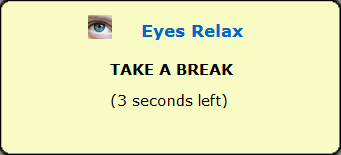Break out the hot hands. This is a good break when you sense a weariness in the air. Have kids rub their hands together vigorously until they warm up. Tell them to close their eyes and place their hands over their eyes. Instruct them to breathe deeply as they clear their mind and refocus. Take a break to groove. Give your eyes a break – Look away from your screen for at least 20 seconds every 20 minutes (the 20-20-20 rule) Have a snack/take a coffee break – your brain needs fuel to work properly. Whatever you do, the qualities of a good break remain the same.
- Break For Eyes
- Screen Breaks For Eyes
- 20 20 20 Rule Eye
- Online Eye Strain Timer
- Computer Break Software
- Breaks For Eyes Inc

Dignitaries and friends from 97 nations and organizations have offered their condolences to Taiwan following the deadly train crash in Hualien County on Friday last week, the Ministry of Foreign Affairs said yesterday, adding that a message from India was significant.
As of noon yesterday, 846 government officials, lawmakers, academics or group representatives from 97 nations and international organizations had offered their condolences to the families of the victims of the train crash, the ministry said.
Indian Ministry of External Affairs spokesman Arindam Bagchi on Saturday last week wrote on Twitter: “We are deeply saddened by the loss of so many lives in the railway accident in Taiwan. Our deepest condolences to the families. And our prayers for the early recovery of the injured.”
Photo: CNA
It was the first time that the ministry had publicly expressed its grief over a major accident in Taiwan since the Taipei Economic and Cultural Center in India was established in 1995, which is significant for bilateral relations, Ministry of Foreign Affairs spokeswoman Joanne Ou (歐江安) told a news conference in Taipei yesterday.
In Taipei, India-Taipei Association Director-General Gourangalal Das had also expressed his condolences on the day of the accident, Ou said, adding that the two nations continue to deepen relations in different areas.
One French national and two Americans were killed in the accident, while one Australian and two Japanese were injured, Ou said.
The ministry is working with the representative offices of those nations, as well as government agencies, to provide the families with the necessary assistance, she said.
Meanwhile, Barbra Streisand yesterday also sent her condolences via Twitter.
Addressing President Tsai Ing-wen (蔡英文) and Minister of Foreign Affairs Joseph Wu (吳釗燮), Streisand wrote: “My heart breaks for you and your country. Reading about this accident brings tears to my eyes for all of these amazing people who lost their precious lives.”
“It’s a tough time for everyone in Taiwan, but we remain strong & will get through this together,” Wu wrote on Twitter in response.
Medically reviewed by Drugs.com. Last updated on May 13, 2020.
Break For Eyes

- Health Guide
What is an Eye Socket Fracture (Fracture Of The Orbit)?
The eye socket is a bony cup that surrounds and protects the eye. The rim of the socket is made of fairly thick bones, while the floor and nasal side of the socket is paper thin in many places. A fracture is a broken bone in the eye socket involving the rim, the floor or both.
Screen Breaks For Eyes
- Orbital rim fracture — These are caused by a direct impact to the face, most commonly by an automobile dashboard or steering wheel during a car crash. Because a great deal of force is required to cause these fractures, they often occur with extensive injuries to other facial bones, and sometimes injuries to the brain. Even if the damage is limited to the eye area, there may be additional injuries to the eye itself, such as the optic nerve (responsible for vision), the eye muscles, the nerves that provide sensation in the forehead and cheek, the sinuses around the eye and the tear duct. There are two types of orbital rim fractures. A zygomatic fracture involves the lower edge of the eye rim, which is part of the cheekbone. A frontal bone fracture or frontal sinus fracture involves the upper edge of the eye rim, which is part of the forehead's frontal bone.
- Indirect orbital floor fracture ('blowout fracture') — This occurs when the bony rim of the eye remains intact, but the paper thin floor of the eye socket cracks or ruptures. This can cause a small hole in the floor of the eye socket that can trap parts of the eye muscles and surrounding structures. The injured eye may not move normally in its socket, which can cause double vision. Most blowout fractures are caused by an impact to the front of the eye from something bigger than the eye opening, such as a baseball, a fist or an automobile dashboard.
- Direct orbital floor fracture — If an orbital rim fracture extends into nearby parts of the eye socket floor, both the rim and the socket floor are fractured.
About 85% of traumatic eye injuries, including eye socket fractures, happen by accident, during contact sports, at work, in car crashes or while doing home repair projects. About 15% are caused by violent assaults. Men suffer from traumatic eye injuries about four times more often than women do. The average age of the injured person is about 30.
The source of the injury is usually a blunt object — baseball, hammer, rock, piece of lumber — and the most frequent place of injury is the home. At one time, eye injuries were common in motor vehicle accidents, usually when a victim's face struck the dashboard. Such eye injuries have decreased dramatically because most cars have airbags and most states have laws mandating the use of seat belts.
Symptoms
Symptoms vary, depending on the location and severity of the fracture, but can include:
- A black eye, with swelling and black and blue discoloration around the injured eye; possible redness and areas of bleeding on the white of the eye and on the inner lining of the eyelids
- Double vision, decreased vision or blurry vision
- Difficulty looking up, down, right or left
- Abnormal position of the eye (either bulging out of its socket or sunken in)
- Numbness in the forehead, eyelids, cheek, upper lip or upper teeth on the same side as the injured eye, possibly related to nerve damage caused by the fracture
- A puffy accumulation of air under the skin near the eye, usually a sign that the fracture has broken through the wall of a sinus cavity, particularly the maxillary sinus, an air-filled chamber located inside the cheek below the eye
- Swelling and deformity of the cheek or forehead, with an obvious dent over the area of broken bone
- An abnormally flat-looking cheek, and possibly severe pain in the cheek when you attempt to open your mouth
Diagnosis
If you are conscious and able to answer questions after your injury, your doctor will review your symptoms and ask how your eye injury occurred. He or she will examine your eye, and will gently touch and press on your cheek and forehead to check if these areas are distorted. The doctor also will check for:
- Whether you can look upward, downward or sideways — If your doctor suspects that one of your eye muscles has become trapped in the fracture site, he or she may grasp the tendon of your eye muscle and attempt to rotate the eye by hand.
- Changes in vision, especially double vision
- Areas of numbness in your forehead, eyelids, cheek, upper lip and upper teeth
- Internal damage — Your doctor will look inside your eye with an instrument called an ophthalmoscope to check for signs of internal damage. If the examination suggests you have an eye socket fracture, the doctor will confirm the diagnosis with X-rays or a computed tomography (CT) scan of the area around your eye.
In someone who is unconscious and has severe facial injuries, doctors can confirm the diagnosis of an eye socket fracture with X-rays and a CT scan of the eye socket bones. This is done after any life-threatening injuries have been addressed and the person's condition has stabilized.
Expected Duration
How long the injury lasts depends on the location and severity of the fracture. In most cases, swelling and discoloration begin to go away within seven to 10 days after the injury, but fractured bones take much longer to heal. If surgery is necessary to repair the injured area, your doctor may delay the procedure for several weeks to allow swelling to go away.
Prevention
Almost all eye injuries can be prevented. To decrease your risk of fracturing your eye socket:
- Use appropriate protective eyewear while working. Studies have shown that face shields, goggles and other protective eyewear can reduce the risk of work-related eye injuries by more than 90%.
- Ask an experienced ophthalmologist, optometrist or optician for help in selecting appropriate protective eyewear for your sport. Baseball and basketball cause the greatest number of eye injuries.
- Do not allow your child to participate in amateur boxing. The American Academy of Pediatrics opposes the sport of boxing for young people.
- Always use a seat belt when you ride in a car, even if your car is equipped with airbags. Seat belts and shoulder harnesses will help to protect your eyes, facial bones and upper body from dashboard impacts and other injuries.
Treatment

Treatment depends on the severity and location of your injury. For a small, uncomplicated blowout fracture that does not affect the movement of your eye, your doctor may prescribe ice packs, decongestants and an antibiotic to prevent infection. You may be told to rest for a few days and to avoid blowing your nose while the eye heals.
If the fracture is more severe, your doctor will refer you to a plastic and reconstructive surgeon who specializes in treating eye injuries. An ophthalmologist may be called in to deal with the double vision. This specialist will determine whether you need surgery to repair the broken bone. Surgery may be needed to:
- Remove bone fragments
- Free trapped eye muscles and eliminate double vision
- Restore the normal architecture of the eye socket if your injured eye looks sunken in
- Repair deformities of the eye rim that affect your appearance
When To Call A Professional
If you suffer a blow to your eye, apply cold packs to the injured area for at least 15 minutes to help reduce pain, swelling and discoloration. Seek medical attention immediately if you experience any of symptoms of an eye socket fracture.
Contact your doctor if you see flashing lights or 'floaters' (spots or shadowy shapes) in your injured eye, or if you have a cut on your eyelid or on the inside surface of your eye.
Prognosis

20 20 20 Rule Eye
In most cases, the outlook is very good. Even when surgery is needed to repair the fracture, most procedures have a high rate of success and a low risk of long-term complications.
External resources
National Eye Institute
http://www.nei.nih.gov/
National Institute of Environmental Health Sciences (NIEHS)
http://www.niehs.nih.gov/
American Academy of Ophthalmology
http://www.aao.org/
American Society of Ophthalmic Plastic and Reconstructive Surgery
http://www.asoprs.org/
Online Eye Strain Timer
U.S. Department of Labor's Occupational Safety & Health Administration (OSHA)
http://www.osha.gov/
Computer Break Software
Further information
Breaks For Eyes Inc
Always consult your healthcare provider to ensure the information displayed on this page applies to your personal circumstances.
